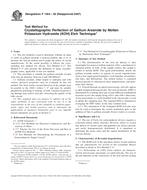We need your consent to use the individual data so that you can see information about your interests, among other things. Click "OK" to give your consent.
ASTM F1404-92(2007)
Test Method for Crystallographic Perfection of Gallium Arsenide by Molten Potassium Hydroxide (KOH) Etch Technique (Withdrawn 2016)
Automatically translated name:
Test Method for Crystallographic Perfection of Gallium Arsenide by Molten Potassium Hydroxide (KOH) Etch Technique
STANDARD published on 1.12.2007
The information about the standard:
Designation standards: ASTM F1404-92(2007)
Note: WITHDRAWN
Publication date standards: 1.12.2007
SKU: NS-50163
The number of pages: 6
Approximate weight : 18 g (0.04 lbs)
Country: American technical standard
Category: Technical standards ASTM
Annotation of standard text ASTM F1404-92(2007) :
Keywords:
crystal perfection, etch pit density, gallium arsenide, potassium hydroxide etch, semiconductor, single crystal, Contamination semiconductors, Crystal lattice structure, Defects semiconductors, Density electronic applications, Etching (materials/process), Etch pit density (EPD), Gallium arsenide, Impurities electronic materials/applications, KOH etch pits, Microscopic examination electronic materials, Molten KOH etch technique, Monocrystalline perfection
Additional information
| Significance and Use | ||||||||
|
The use of GaAs for semiconductor devices requires a consistent atomic lattice structure. However, lattice or crystal line defects of various types and quantities are always present, and rarely homogeneously distributed. It is important to determine the mean value and the spatial distribution of the etch pit density. |
||||||||
| 1. Scope | ||||||||
|
1.1 This test method is used to determine whether an ingot or wafer of gallium arsenide is monocrystalline and, if so, to measure the etch pit density and to judge the nature of crystal imperfections. To the extent possible, it follows the corresponding test method for silicon, Test Method F 47. Test Method F 47 also presents the definition of many crystallographic terms, applicable to this test method. 1.2 This procedure is suitable for gallium arsenide crystals with etch pit densities between 0 and 200 000/cm2. 1.3 Gallium arsenide, either doped or undoped, and with various electrical properties, may be evaluated by this test method. The front surface normal direction of the sample must be parallel to the <001> within ± 5° and must be suitably prepared by polishing or etching, or both. Unremoved processing damage may lead to etch pits, obscuring the quality of the bulk crystal. 1.4 This standard does not purport to address all of the safety problems, if any, associated with its use. It is the responsibility of the user of this standard to establish appropriate safety and health practices and to determine the applicability of regulatory limitations prior to use. Specific hazard statements are given in Section 8. |
||||||||
| 2. Referenced Documents | ||||||||
|
We recommend:
Technical standards updating
Do you want to make sure you use only the valid technical standards?
We can offer you a solution which will provide you a monthly overview concerning the updating of standards which you use.
Would you like to know more? Look at this page.




 Cookies
Cookies
